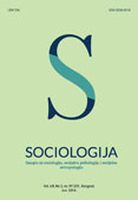„Dijete kao projekt” vs „daj dite materi” orodnjenost roditeljske brige o djeci
"The child as a project" vs "give the child to the mother" - parental child care
Author(s): Željko Boneta, Željka Ivković, Sandra KanjićSubject(s): Social Sciences
Published by: Sociološko naučno društvo Srbije
Keywords: gender division of labour; gender division of child care; child as a project
Summary/Abstract: The paper tries to connect two theoretical concepts: „child as a project” and gender division of household work involving childcare. Although these concepts are tightly interrelated and intertwined and it might seem that it is not possible to talk about the one without the other, the impression is that in research where they are trying to be connected, the modern concept of „child as a project” appears in theoretical-interpretative function of research, but the operationalization is stopped in determining those activities which belong in more traditional construction of childhood, now already classically expressed by dichotomy of childcare in opposition to play and fun with child. This paper tends to broaden such dichotomous model by practices that would represent parental investment in child and verify if and how much these practices are gendered. For this purpose, we conducted survey in 2013. with parents (N=261) whose children attend kindergartens in the area of city of Rijeka. Since our research involved parents of children of early and preschool age, the third dimension of our theoretical model was directed into educational activities of parents typical of that child age as a backbone of „project” approach to childhood. An instrument of Likert type was constructed containing 15 items by which we covered all three dimensions. Factor analysis under the component model extracted four factors. Analysis showed that the activities of childcare are still dominantly maternal activities, while play and fun with child, as well as activities directed into setting the good educational foundation, are the domain of both parents. It seems, at least according to our sample, that the parental investment in child is more of a common practice of both parents, but that some traditional divisions still maintain.
Journal: Sociologija
- Issue Year: 56/2014
- Issue No: 4
- Page Range: 495-505
- Page Count: 11
- Language: Croatian

